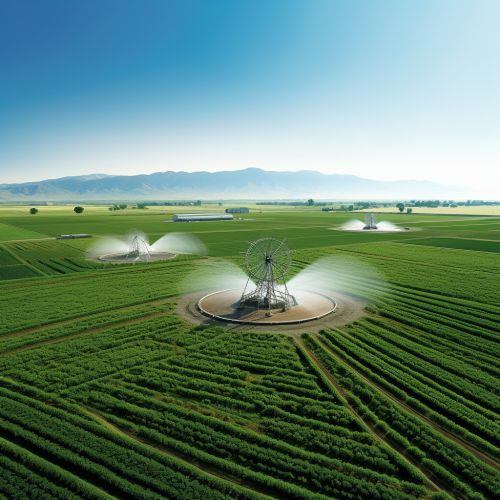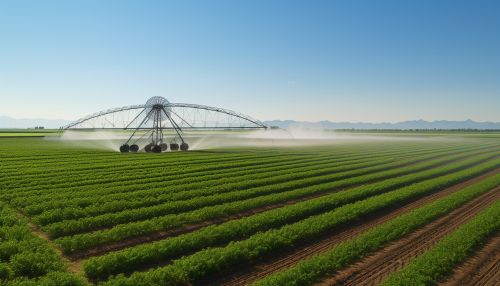Center Pivot Irrigation
Overview
Center pivot irrigation, also known as circular irrigation, is a method of crop irrigation in which equipment rotates around a pivot and crops are watered with sprinklers. A circular area centered on the pivot is irrigated, often creating a circular pattern in crops when viewed from above. This method of irrigation is highly efficient and versatile, making it a popular choice for farmers worldwide.
History
The concept of center pivot irrigation was first developed in the United States in the mid-20th century. Frank Zybach, a farmer and inventor from Colorado, is credited with patenting the first practical center pivot irrigation system in 1952. Zybach's invention revolutionized agriculture, particularly in arid regions where rainfall is scarce or unpredictable. Over the years, the technology has been refined and improved, with modern systems incorporating advanced features such as GPS and remote monitoring.
Design and Operation
A typical center pivot irrigation system consists of a series of segmented pipes, mounted on wheeled towers, that rotate around a central pivot point. At the outer end of the pipe is a sprinkler system that distributes water to the crops. The system is powered by electric motors, which drive the wheels and pump the water.
The water for the system is usually sourced from a well and is pumped through the pipes to the sprinklers. The rate of water application can be controlled to match the water needs of the crop, the soil type, and the local climate conditions. This precise control over water application makes center pivot irrigation a highly efficient method of irrigation.


Efficiency and Advantages
Center pivot irrigation is known for its efficiency. It can deliver water directly to the root zone of plants, minimizing evaporation and runoff. This method of irrigation also allows for the precise application of fertilizers and pesticides, which can be mixed with the irrigation water and applied directly to the crops.
In addition to its water efficiency, center pivot irrigation offers several other advantages. The system can be automated, reducing labor costs and allowing for more precise control over watering times and amounts. The circular pattern of irrigation also maximizes the use of available land, as there are no unirrigated corners as in traditional rectangular field irrigation.
Limitations and Challenges
Despite its many advantages, center pivot irrigation is not without its limitations and challenges. The initial cost of installing a center pivot irrigation system can be high, particularly for large-scale operations. The system also requires a reliable source of power to operate, which can be a challenge in remote or off-grid locations.
Additionally, while center pivot irrigation is highly efficient in terms of water use, it can still contribute to the depletion of groundwater resources if not managed sustainably. Over-reliance on center pivot irrigation in some regions has led to significant drops in groundwater levels, raising concerns about long-term water security.
Environmental Impact
The environmental impact of center pivot irrigation is a topic of ongoing research and debate. On one hand, the method's water efficiency can help conserve water resources and reduce the impact of agriculture on local water systems. On the other hand, the large-scale alteration of landscapes for center pivot irrigation can have significant ecological impacts, including changes in local climate conditions and loss of habitat for wildlife.
Future Developments
The future of center pivot irrigation is likely to be shaped by advances in technology and shifts in agricultural practices. Developments in remote sensing and automation technologies are expected to further improve the efficiency and ease of use of center pivot systems. At the same time, growing awareness of the need for sustainable water management in agriculture may lead to changes in how center pivot irrigation is used and managed.
